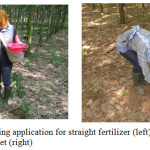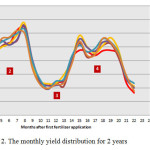Introduction
Rubber trees require sufficent nutrition to be able to perform good growth and yield. The experiment result showed that the immature period of rubber tree can be shorthened by optimum fertilizer apllicaton (Adiwiganda et al., 1995 , and Sihotang, 1993). Also on mature rubber tree, fertilizer appplication can improve latex yield up to 15-30% (Adiwiganda et al., 1994). Response of rubber tree to fertilizer application depends on the nutrient satus of rubber tree. Rubber trees that are nutroient deficient, the effect of fertilizer application could be seen in short time that is one year or less (Ismail, 1981).
Manuring recommendation is generally based mainly on the requirement of macro nutrient N, P, K, and Mg (Adiwiganda et al., 1994), while the micro nutrient is considered small and can be satified by the soil. The role of micronutrient get less attention on rubber trees (Yogaratnam and Perera, 1985). Brady (1984) stated that the attention to micro nutrient is growing because of micro nutrient uptake loss due to harvest so that the nutrient source become depeleted and nutrient supply become less, the use of high yielding variety of plant that increase nutient removal and the improved knowlede of plant nutrition so that it can help in micro nutreint diagnose that it had been ignored in the past.
It has been discussion among Indonesian rubber planters questioning the necessary of manuring on the mature rubber. Some planters considered it is not neccesaary to apply fertlizer on mature tree, and there is also some trials showing less response of mature tree on fertlizer application when nutrient status on leaf was high (Thomas and Hidayati, 2003). Also it is common practise that when the price of rubber is low, the planter cut down the budget for purchasing fertilizer.
In this experiment, it tested the NPK Tablet fertilizer with size of 10 gram for each tablet containing N, P, K, and Mg and kaolinite as slow release agent and compared with straight fertlizer (Urea, SP 36, KCl, and Kieserite) and control without manuring.
Materials and Methods
The experiment was conducted in Sembawa Research Centre. The experiment was arranged in randomized block design with 6 treatments and 4 replications. The experiment was conduted on mature tree on the second year of tapping from opening. Rubber clone in this experiment was PB 260, and the plot size was 50 trees.
The Fertilizer Type used in this Experiment were
- Compound NPK tablet fertilizer with composition of NPK 17-10-18-2 (17% N, 10 % P2O5, 18% K2O, 2 % MgO).
- Straight fertilizer : Urea, SP 36, KCl and Kieserite (containing 46% N, 36 % P2O5, 60% K2O, and 26% MgO, respectively)
The treatments were as follow
Table 1: The Treatment of Fertlizer Application on Mature Tree PB 260
|
No. |
Treatment |
|
1 |
Control (without fertilizer application) |
|
2 |
General dose (GD) with straight fertilizer (350 g/tree/year Urea, 260 g/tree/year SP 36, 300 g/tree/year KCl, and 75 g/tree/year Kieserite) |
|
3 |
750 g/tree/year NPK Tablet (equal to 75% GD) |
|
4 |
500 g/tree/year NPK Tablet (equal to 50% GD) |
|
5 |
250 g/tree/year NPK Tablet (equal to 20% GD ) |
|
6 |
150 g/tree/year NPK Tablet (equal to 15% GD ) |
Application of NPK Tablet and straight fertilizer was carried in 2 times every year i.e. on April and October. Straight fertilizer was applied by broadcasting method, while NPK tablet was applied in 4 holes (Figure 1)
 |
Figure 1: Broadcasting application for straight fertilizer (left) and application in 4 holes for NPK tablet (right). |
Parameter observed were latex yield, girth and the renewed bark thickness, the soil and leaf nutrient before and at the end of experiment.
Results and Discussion
Soil Nutrient
Soil nutrient before the implemantation of treatment is shown in Table 2. In general, the content of N, P2O5, K, Ca, and Mg were categorized as low (Adiwiganda et al., 1994), so that it may imply that the fertilzer appplication is needed.
Table 2: The Soil Nutrient Content.
| Parameter |
Value |
| pH |
3.89 |
| N (%) |
0.13 |
| P2O5 Bray II (ppm) |
0.85 |
| K (me/100 g) |
0.009 |
| Ca (me/100 g) |
0.009 |
| Mg (me/100 g) |
0.001 |
| CEC (me/100 g) |
9.1 |
At the end of experiment , the soil nutrient analysis is presented in Table 3. The content of N was not different among treatment, but the content of P, K, and Mg were different among treatments. This indicated that the fertilizer application for 2 years increase the nutrient content of soil.
Table 3: The Soil Nutrient Content at the end of Experiment.
|
Treatment |
pH H2O |
N % |
Bray II |
Exchangeable Cation (NH4 Acetate pH 7) |
|||
|
P2O5 |
K |
Ca |
Mg |
CEC |
|||
|
Ppm |
…..me/100 gr….. |
||||||
|
Control |
5.03 a |
0.19 a |
0.41 a |
0.008 a |
0.35 a |
0.005 a |
16.67 c |
|
General dose |
4.87 a |
0.17 a |
4.46 c |
0.013 ab |
0.38 a |
0.005 a |
13.66 bc |
|
NPK Tablet 750 g |
4.66 a |
0.18 a |
5.16 c |
0.025 b |
0.35 a |
0.011 ab |
11.05 b |
|
NPK Tablet 500 g |
4.87 a |
0.15 a |
2.63 b |
0.015 ab |
0.41 a |
0.005 a |
8.23 a |
|
NPK tablet 250 g |
4.76 a |
0.15 a |
9.96 d |
0.010 a |
0.41 a |
0.009 ab |
7.50 a |
|
NPK Tablet 150 g |
5.05 a |
0.14 a |
2.59 b |
0.009 a |
0.45 a |
0.021 b |
12.94 b |
The Leaf Nutrient Content
The nutrient content in leaf before the treatment is presented in Table 4. In general the leaf nutrient content in experimental area were generally high except N was considered low according to nutrient classification of nutrient (Adiwiganda et al, 1994)
Table 4: The Nutrient Content on Leaf at the beginning.
|
Nutrient content on leaf (%) |
|||||
|
N |
P |
K |
Ca |
Mg |
|
|
3.08 |
0.26 |
2.73 |
1.39 |
0.49 |
|
The leaf nutrient content on leaf at the end of experiment is presented in Table 5. In general, the appplication of NPK Tablet fertilizer resulted in higher N compared with control and general recommended dose with straight fertilizer. The leaf nutrient content of P, K, Ca and Mg were not different among treatments.
Table 5: The Nutrient Content at the end of Experiment.
|
Treatment |
N |
P |
K |
Ca |
Mg |
|
………… % ……….. |
|||||
|
Control |
2.35 a |
0.31 a |
1.06 a |
0.53 a |
0.23 a |
|
GD |
2.56 ab |
0.31 a |
0.96 a |
0.51 a |
0.27 a |
|
NPK Tablet 750g |
3.96 c |
0.38 a |
1.05 a |
0.97 a |
0.29 a |
|
NPK Tablet 500 g |
3.95 c |
0.35 a |
0.97 a |
0.91 a |
0.23 a |
|
NPK tablet 250 g |
3.99 c |
0.35 a |
1.06 a |
0.92 a |
0.31 a |
|
NPK Tablet 150 g |
3.97 c |
0.31 a |
0.86 a |
1.01 a |
0.29 a |
Note : Number followed by the same letter are not significantly different at p< 5%.
Renewed Bark Thickness
The renewed bark thickness is shown in Table 6. The renewed bark thickness after 2 year of tapping showed significant different among treatment. The treatment of NPK Tablet equal to 75% of general dose showed the best treatment among treatments. Bark thickness is related to yield. The renewed bark would be tapped later on after the BO1 panel is tapped and the thickness would determine yield. Without fertilizer application the bark thickness was lower and this may imply that the future yield will be lower on control.
Table 6: The Renewed Bark Thickness after 2 Years of Tapping.
|
Treatment |
Renewed bark thickness (mm) |
|
|
Control |
4.3 a |
|
|
General dose |
4.9 ab |
|
|
NPK Tablet 750g |
5.5 b |
|
|
NPK Tablet 500 g |
5.3 ab |
|
|
NPK tablet 250 g |
5.2 ab |
|
|
NPK Tablet 150 g |
5.1 ab |
Note : Numbers followed by the same letter were not significant different at level p< 5%.
Rubber Yield (Gram/Tree/Tapping)
Rubber mean annual yield is presented in Table 7 and the monthly yield is shown in Figure 2. The average annual yield in the first year of treatment was not significant among treatments. It meant that fertilizer ommision did not take effect on yield in first year. This probably due to the residual effect of application of previous years before the commencement of treatment imposed in this experiment. However, in second year, the yield was wignificnatly different. Without fertilizer application for 2 year in control, the yield was the lowest compared with other treatments. At the second year, the NPK tablet 75% of general dose was the best treatment resulting in highest yield.
Table 7: Rubber Yield for the First and Second Year.
|
Treatment |
Average yield (g/tree/tapping) |
|
|
First year |
Second year |
|
|
Control |
39.90 a |
36.58 a |
|
General Dose |
38.80 a |
38.08 ab |
|
NPK Tablet 750g |
39.81 a |
40.95 c |
|
NPK Tablet 500 g |
39.94 a |
39.81 bc |
|
NPK tablet 250 g |
40.04 a |
40.65 c |
|
NPK Tablet 150 g |
38.62 a |
38.35 ab |
Note : The number followed by the same letter are not significantly different at p = 5%.
The monthly yield distribution (Figure 2) shows that yield from August to October declines due to wintering time and in November the yield increase due to completeness of leaf formation. The fertilizer application resulted in higher yield compared with control in year 2013.
 |
Figure 2: The monthly yield distribution for 2 years. |
Conclusion
Based on 2 years experimental reserach, it can be concluded that omission of fertilizer appplication will reduce the yield at the second year. Among the fertilizer treatment, NPK tablet equal to 75% of general dose gave the highest yield. The NPK tablet with slow release agent is more efficient in term of nutrient uptake compared with straight fertilizer and this was shown by higher N concentration in the leaf.
References
- Adiwiganda, Y.T., Hardjono, A., Manurung, A., Sihotang, U.T.B., Darmandono, Sudiharto, Goenadi, D.H., Sihombing, H. 1994. Manuring recommendation technique for rubber plantation. Rubber Forum. Indonesian Rubber Research Institute.
- Adiwiganda, Y.T., Siahaan, A.E. Perangin-angin, J.P. dan Darminta, S. 1995. Tinjauan pemendekan masa remaja tanaman karet di PT Goodyear Sumatra Plantations dan PT Perkebunan IV Gunung Pamela. Indonesian Rubber Research Institute News. 14(2):76-88.
- Brady, N.C. 1984. The nature and property of soils. Macmillan Publishing Company. Ninth Edition, 365pp.
- Ismail, T. 1981. Responses to fertilizers on growth and yield of rubber. RRIM training manual on Soils, soil management and nutrition of hevea. p.93-100
- Sihotang, U.T.B. 1993. Fertilizer system to shorten the immature period of rubber. Rubber Bulletin, 11(1-3):25-32
- Thomas Wijaya and Umi Hidayati. 2013. The review of fertilizer application on mature rubber trees. Indonesian Rubber Research Institute News, 22 (2-3) :41-50
- Yogaratnam, N. and Perera, A.M.A. 1985. Micronutrients in hevea nutrition under Sri Lankan conditions. International Rubber Conference. Session 9: Plantation Practices. Kuala Lumpur. 24 October 1985. 17p
